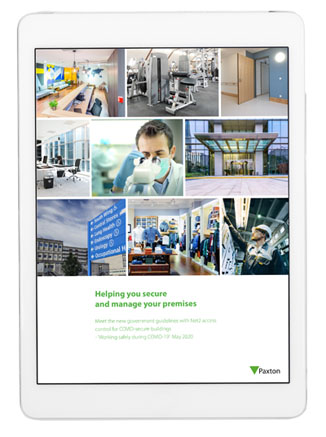With an increased emphasis on businesses and organisations moving to the ‘new normal’, allowing them to open up for trade and interaction with the public, a greater focus is being placed on the management of occupancy, both in terms of social distancing and the control of flow through a site to meet evolving regulations and advice.
The COVID-19 pandemic and subsequent lockdowns and regulated operations have introduced challenges for a wide number of sites, both those who face significant levels of customers and visitors, and sites which are more focused on more restricted use mainly by employees and contractors. Government advice has been issued to address the specific requirements of many applications, including retail, hospitality, offices and contact centres, factories and warehouses, etc..
While the advice differs dependent upon the specific application and its associated risks, one theme which is common throughout the advice is the need to maintain social distancing. Reducing the level of contact between people has proven to be a key issue in controlling the pandemic, and remains one of the most important steps which businesses and organisations must manage when reopening.
Managing occupancy is a multi-faceted task. It incorporates entry and exit control, with one-way flow enforced whenever possible. There is also a need to minimise numbers of people congregating in common areas such as canteens, atriums and corridors. It is also critical to ensure occupancy of rooms, offices or other spaces do not exceed safe levels, including the need to manage flow, often on a one-in, one-out basis.
For many sites, the evolving nature of pandemic management and uncertainty over future investments means many businesses are looking to leverage the flexibility in legacy systems, often looking to exploit current or new features rather than reinvesting in new solutions.
Thankfully for many sites who use access control, the core data gathering and management facilities already exist, and with a few additional features can form the backbone of a credible occupancy management system.
An access base
Access control forms a powerful base for occupancy management because of its core functions. Access control can effectively manage each and every individual on site, granting them access to or egress from a building, as well as managing their movements within the building itself. It enforces permissions relating to access rights on a building, floor, department or even room by room level, as well as using time zones and other real-time data to manage who can go where, and when.
Regular staff can be identified through the use of credentials, and visitors can also be tracked using temporary digital credentials. The data is available in real-time, and transactional information can be interrogated for additional purposes.
In sites where the flow of people is regulated, access control offers one of the most cost-effective solutions, and introducing basic processes to meet Government guidance is straightforward. For example, guidance suggests that sites should implement rolling start and finish times for workers to prevent overcrowding in entrances and corridors when the working day starts and finishes. Adjusting time zones for access privileges on a department by department basis can implement such a procedure.
Ensuring that certain doors and entry-only or exit-only is another benefit of access control and again helps meet the guidelines. With the introduction of door openers, access control can also allow touch-free entry and exit.
However, further simple upgrades can elevate the role of the system in occupancy management.
 Net2 Occupancy Management
Net2 Occupancy Management
Paxton has added occupancy management to its popular Net2 access control range. With the launch of Net2 v6.04 Pro software, it is possible to accurately manage the flow of people around a building, as well as controlling the maximum number of people permitted in any specific area at one time. The new functionality has been specifically developed to support social distancing and make buildings COVID-secure in the return to ‘New Normal’ working conditions.
Net2 Occupancy Management allows users to limit the number of people in any given area, either barring access or sending an email or text to the building manager when a space nears capacity. It works across multiple areas of a site and can be set to operate a ‘one in, one out’ system to support social distancing measures. In addition to this update, those who want to use thermal scanning can do so with a choice of hardware integrated from Hikvision, Dahua and ZKTeko.
Occupancy Management sets and controls the maximum number of people in an area or space. Users can view live occupancy levels in a clear, web-based visual report from a smartphone, tablet, PC or wall display. Dynamic control of entry permissions allows users to set alerts and prevent access when maximum capacity is neared or reached, and a simplified area management feature sets and manages multiple areas simultaneously, with specific occupancy levels per area. The functionality has been designed to support continuous flow of people movement with ‘one-in, one-out’ access when occupancy numbers are high.
Paxton has tested a range of thermal scan hardware and uses its latest free, 45 minute webinars to explain what is available and how to apply it. Paxton reference solutions from Hikvision’s Face Recognition Terminal (Minmoe), Dahua’s Thermal Temperature Station and ZKTeko’s SpeedFace help ensure health and well-being in high security areas and quickly identify people who could be at risk. However, Net2 will integrate with any thermal cameras which utilise a Wiegand output.
Following the release of the new UK government guidelines in May 2020: ‘Working safely during COVID-19’, Paxton has been running its ‘Definitive guide to COVID-secure buildings’ webinar to help get the UK back to work safely. The webinar takes viewers through the new guidelines as well as providing a free end-user guide to help customers understand the access control solutions available when updating their buildings.


 Net2 Occupancy Management
Net2 Occupancy Management